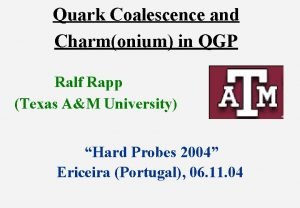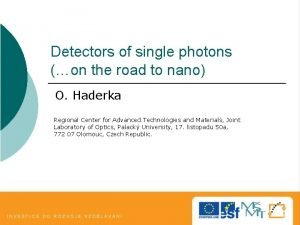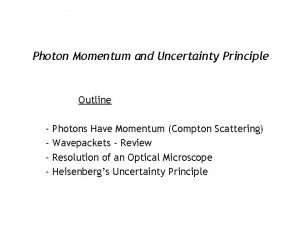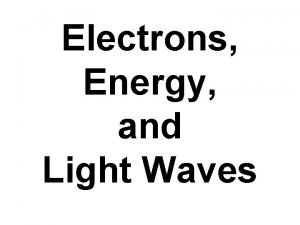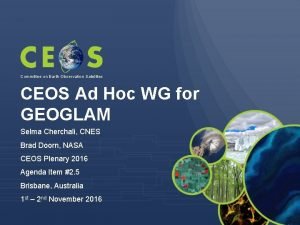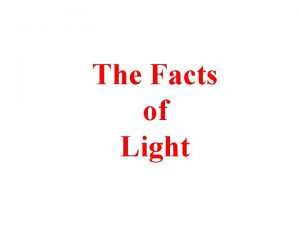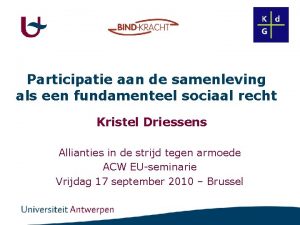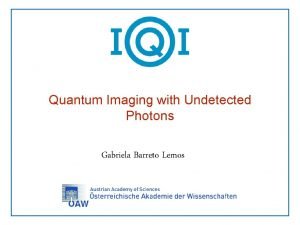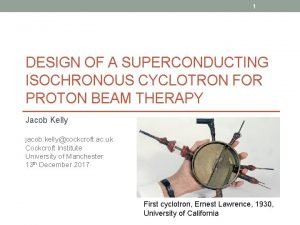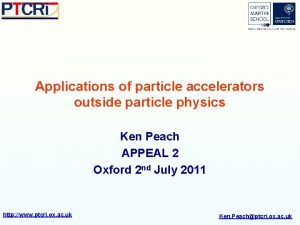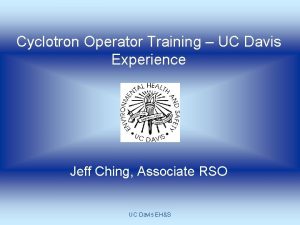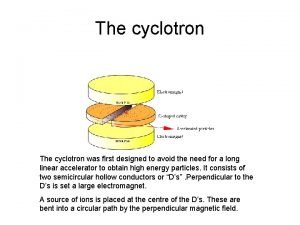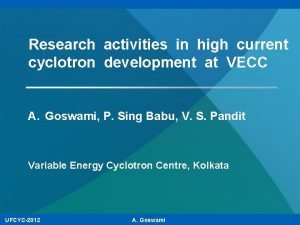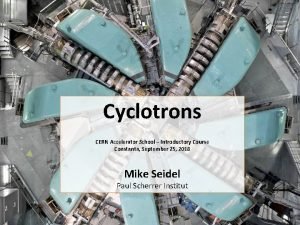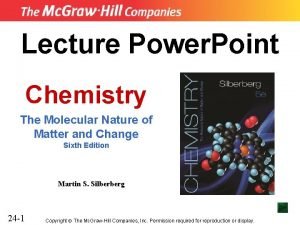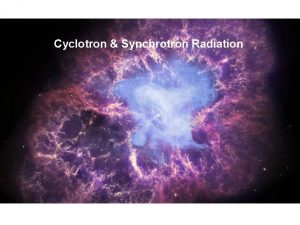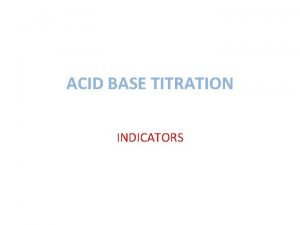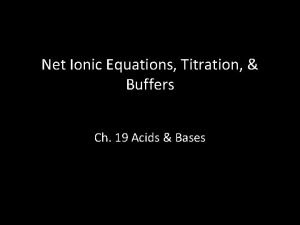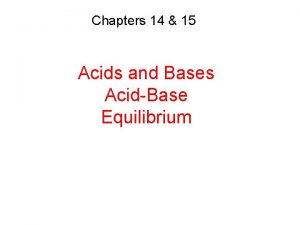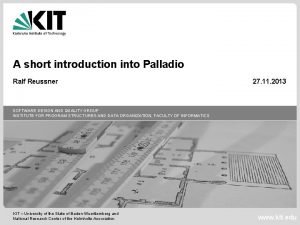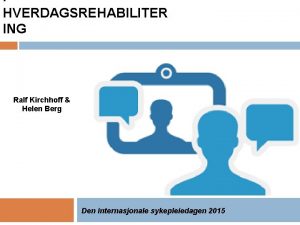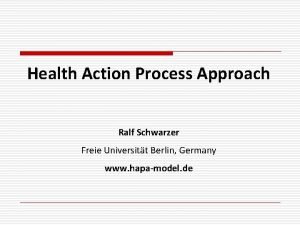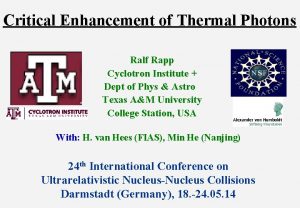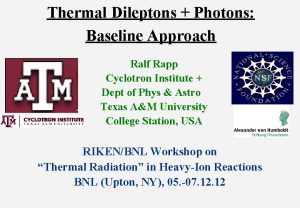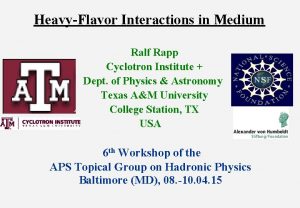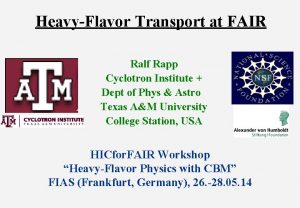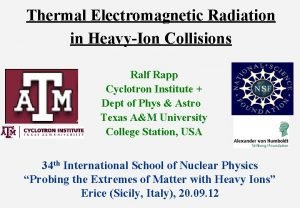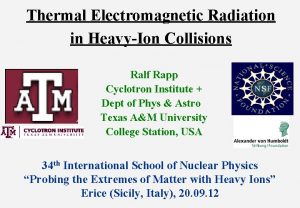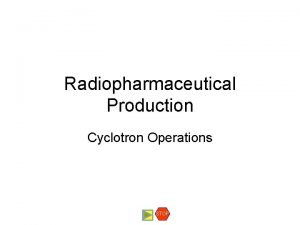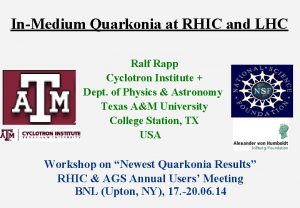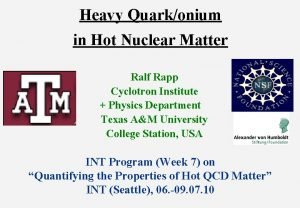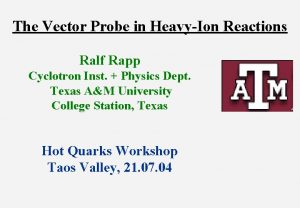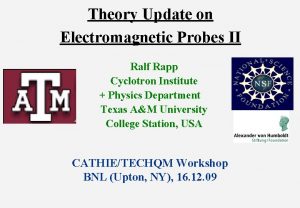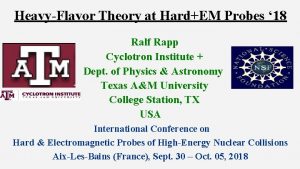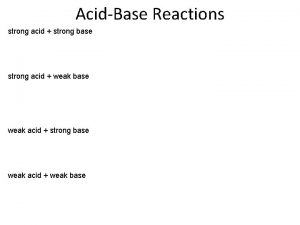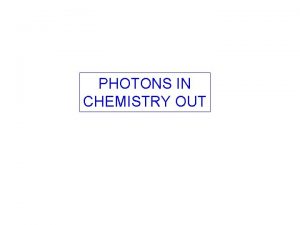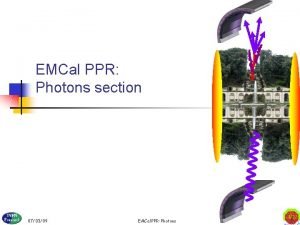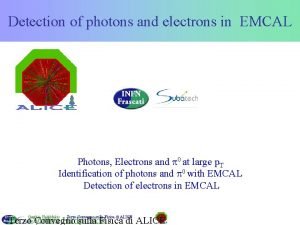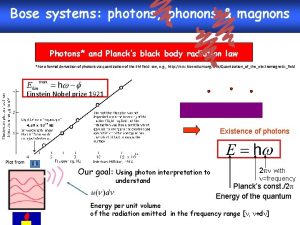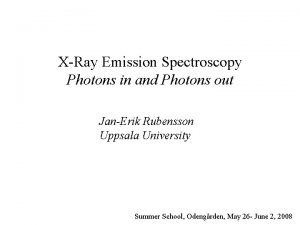Thermal Photons in Strong Interactions Ralf Rapp Cyclotron
















![3. 2 Thermal Evolution: QGP→ Mix→ HG HG: chemistry and trans. chemistry [LHC]flow T 3. 2 Thermal Evolution: QGP→ Mix→ HG HG: chemistry and trans. chemistry [LHC]flow T](https://slidetodoc.com/presentation_image_h/cd4902d9341809bdfbecabbfba1c5199/image-17.jpg)













- Slides: 30

Thermal Photons in Strong Interactions Ralf Rapp Cyclotron Inst. + Physics Dept. Texas A&M University College Station, USA College Station, 24. 09. 04

Introduction I: E. M. Probes in Strong Interactions • g-ray spectroscopy of atomic nuclei: collective phenomena • DIS off the nucleon: - parton model, PDF’s (high Q 2) - nonpert. structure of nucleon [JLAB] • thermal emission: - compact stars (? !) - heavy-ion collisions What is the electromagnetic spectrum of matter? c. PT many-body (2 ↔ 2) consistent 0 0. 05 120 ½r 0 degrees of freedom? QGP (3 -body, . . . ) extrapolate 0. 3 150 -160 2 r 0 0. 75 175 5 r 0 (resonances? ) p. QCD e[Ge. Vfm-3] T [Me. V] rhadron

Outline 1. Introduction 2. Thermal Photon Emission Rates 2. 1 Generalities 2. 2 Quark-Gluon Plasma: Complete LO 2. 3 Hadronic Matter: - Meson Gas - Baryonic Contributions - Medium Effects 3. Relativistic Heavy-Ion Collisions 3. 1 Nonthermal Sources 3. 2 Thermal Evolution 3. 3 Comparison to SPS and RHIC Data 4. High-Density QCD: Colorsuperconductor 5. Conclusions

Introduction II: Electromagnetic Emission Rates E. M. Correlation Function: e+ e- Im Πem(M, q) = O(1) γ Im Πem(q 0=q) = O(αs ) also: e. m susceptibility (charge fluct): χ = Πem(q 0=0, q→ 0) In URHICs: • source strength: depend. on T, m. B, mp ; medium effects, … • system evolution: V(t), T(t), m. B(t) ; transverse expansion, … • nonthermal sources: e+e-: Drell-Yan, open-charm; g: initial/ • consistency! pre-equil.

2. Thermal Photon Radiation 2. 1 Generalities Emission Rate per 4 -volume and 3 -momentum T Im Πem(q 0=q) many-body language: p γ r transverse photon selfenergy cut kinetic theory: p γ r p in-medium effects, resummations, … 2 |M|2

2. 2 Quark-Gluon Plasma “Naïve” Leading Order Processes: q + q (g) → g (q) + γ q q g [Kapusta etal ’ 91, Baier etal ’ 92] But: other contributions to O(αs) collinear enhanced Dg=(t-m. D 2)-1 ~ 1/αs Bremsstrahlung Pair-ann. +scatt. + ladder resummation (LPM) [Aurenche etal ’ 00, Arnold, Moore+Yaffe ’ 01]

2. 3. 1 Hot Hadronic Matter: p-r-a 1 Gas Chiral Lagrangian + Axial/Vector-mesons, e. g. HLS or MYM: • (g 0, m 0, s, x) fit to mr, a 1 , Gr, a 1 D/S and G(a 1→pγ) not optimal [Song ’ 93, Halasz etal ’ 98, …] HLS MYM Kap. ’ 91 (no a 1) • Photon-producing reactions: p γ p p r r γ p, a 1 p mostly at dominant (q 0>0. 5 Ge. V) q 0<0. 5 Ge. V a 1 -strength problematic p, a 1 gauge invariance!

2. 3. 1. b Hadronic Formfactors • quantitative analysis: account for finite hadron size • improves a 1 phenomenology • t-channel exchange: gauge invariance nontrivial [Kapusta etal ’ 91] simplified approach: [Turbide, Gale+RR ’ 04] with Factor 3 -4 suppression at intermediate and high photon energies

2. 3. 2 Further Meson Gas Sources (i) Strangeness Contributions: SU(3)F MYM p γ K K* ~25% of pp→ργ (ii) w t-Channel [Turbide, Gale +RR ’ 04] p K* p w r γ p p γ K ~40% of pr→pγ ! Gwrp large! potentially important … (iii) Higher Resonances Ax-Vec: a 1, h 1→pg, Vec: f 1→rg , K 1→Kg w, w’’→pg other: p(1300)→pg K*→Kg a 2(1320)→pg

2. 3. 3 Baryonic Contributions • use in-medium r –spectral funct: • constrained by nucl. g-absorption: r Sp Sp B*, a 1, K 1. . . > N, p, K… g N → p N, D g N → B* > [Urban, Buballa, RR+Wambach ’ 98] g. N g. A p-ex

2. 3. 3(b) Photon Rates from r Spectral Function: Baryons + Meson-Resonances • baryonic contributions dominant for q 0<1 Ge. V (CERES enhancement!) • also true at RHIC+LHC: m. B=220 Me. V at T=180 Me. V, m. B=0

2. 3. 4 HG Emission Rates: Summary • w t-channel (very) important at high energy • formfactor suppression (2 -4) • strangeness significant m. B=220 Me. V [Turbide, RR+Gale ’ 04] • baryons at low energy

2. 3. 5 In-Medium Effects • many-body approach: encoded in vector-spectral function, relevant below M , q 0 ~ 1 -1. 5 Ge. V • “dropping masses”: large enhancement due to increased phase space [Song+Fai ’ 98, Alam etal ’ 03] unless: vector coupling decreases towards Tc (HLS, a→ 1) [Harada+Yamawaki ’ 01, Halasz etal ’ 98]

2. 3. 6 Hadron Gas vs. QGP Emission • complete LO QGP rate ~2 -3 above tree-level rate • in-med HG + Meson-Ex (bottom-up) ≈ complete LO QGP (top-down) “quark-hadron duality” ? ! • Similar findings for thermal dilepton rates not yet understood …

3. Relativistic Heavy-Ion Collisions J/y Au + Au e+ e- r QGP ? ! Hadron Gas “Freeze-Out” Signatures of the QGP? • Suppression of J/y Mesons • Decays of r-Mesons • Photons … Au + Au → X

3. 1 Nonthermal Sources Initial hard production: pp → γX Nuclear Effects: p. A → g. X scaling with x. T=2 p. T /√s , + power-law fit [Srivastava ’ 01] • “Cronin”: gaussian kt-smear. • cf. p. A → πX • AA: <Dkt 2>AA≈ 2<Dkt 2>p. A
![3 2 Thermal Evolution QGP Mix HG HG chemistry and trans chemistry LHCflow T 3. 2 Thermal Evolution: QGP→ Mix→ HG HG: chemistry and trans. chemistry [LHC]flow T](https://slidetodoc.com/presentation_image_h/cd4902d9341809bdfbecabbfba1c5199/image-17.jpg)
3. 2 Thermal Evolution: QGP→ Mix→ HG HG: chemistry and trans. chemistry [LHC]flow T [Ge. V] QGP: initial conditions [SPS] • t 0=1 fm/c → t 0=0. 5 fm/c: ~2 -3 • s=Cd. QGT 3; d. QG=40 → 32: ~2 • pre-equilibrium? ! • R~exp(3 mp) for pg , … • conserved BB pr use→entropy • yield up at of lowmqpt>0 , down above • build-up (Np=const) • large blue shiftcooling from coll. flow • accelerated

3. 3 Comparison to Data I: WA 98 at SPS Hydrodynamics: QGP + HG [Huovinen, Ruuskanen+Räsänen ’ 02] • T 0≈260 Me. V, QGP-dominated • still true if pp→g. X included Expanding Fireball + Initial [Turbide, RR+Gale’ 04] • initial+Cronin at qt >1. 5 Ge. V T 0=205 Me. V suff. , HG dom.

3. 3 Comp. to Data II: WA 98 “Low-qt Anomaly” Expanding Fireball Model [Turbide, RR+Gale’ 04] • current HG rate much below • 30% longer t. FB 30% increase Include pp→ppg S-wave • slight improvement • in-medium “s” or D ? !

3. 3 Perspectives on Data III: RHIC Predictions for Central Au-Au • large “pre-equilibrium” yield from parton cascade (no LPM) • thermal yields ~ consistent • QGP undersat. small effect PHENIX Data • consistent with initial only • disfavors parton cascade • not sensitive to thermal yet

4. Photon Emission from Colorsuperconductor Cold Quark Matter → (qq) Cooper pairs, Dqq≈100 Me. V mq » ms 2 : u-d-s symmetrically paired (Color-Flavor-Locking) ciral symmetry broken, Goldstone bosons, mp 2 ~ mq 2 ≈ (10 Me. V)2 Photon Emissivities Effective theory description of “hadronic” processes: γ γ exceeds e+e-→γγ for T≥ 5 Me. V [Vogt, Ouyed+RR]

5. Conclusions • significant progress in E. -M. radiation from QCD matter: - QGP: soft collinear enhancement → complete leading order - HG: more complete (strangeness, baryons, w t-chan, FF’s) • extrapolations into phase transition region HG and QGP shine equally bright deeper reason? lattice calculations? • phenomenology for URHIC’s compares favorably with existing data • consistency with dileptons • much excitement ahead: PHENIX, NA 60, HADES, ALICE, … and theory!

Additional Slides

Photon Properties in Colorsuperconductors

r Sp Sp B*, a 1, K 1. . . + N, p, K… (i) r(770) > > 2. 2. 2 1± Mesons: Significance of high r. B at low M Constraints: - branching ratios B, M→r. N, rp - g. N, g. A absorpt. , p. N→r. N - QCD sum rules Elab=20 -40 AGe. V optimal? !

2. 2. 4 In-Medium Baryons: D(1232) long history in nuclear physics ! ( p. A , g. A ) e. g. nuclear photoabsorption: MD, GD up by 20 Me. V little attention at finite temperature D-Propagator at finite r. B and T in-medium p-cloud, (1+ f p - f N) > > + > DN-1 > D Sp NN-1 [van Hees + RR ’ 04] > vertex corrections incl. g’ (“induced interaction”) + + . . . > p. D→N(1440), N(1520), D(1600) thermal p-gas

(i) Check: D in Vacuum and in Nuclei → ok !

(ii) D(1232) in URHICs broadening: Bose factor, p. D→B repulsion: p. DN-1, p. NN-1 not yet included: (p. N→D)

Comparison of Hadronic Models to LGT calculate integrate More direct! Proof of principle, not yet meaningful (need unquenched)

2. 2. 6 Observables in URHICs (i) Lepton Pairs e+ e. Im Πem(M, q) γ (ii) Photons Im Πem(q 0=q) [Turbide, Gale+RR ’ 03] baryon density effects! • consistent with dileptons • pp Brems with soft s at low q?
 Ralf rapp
Ralf rapp Ephesians 6 10-20 nkjv
Ephesians 6 10-20 nkjv Rapp method
Rapp method Gianluca verona rinati
Gianluca verona rinati Do photons have momentum
Do photons have momentum Rapp method
Rapp method What are photons made of
What are photons made of Geoglam rapp
Geoglam rapp Facts of light
Facts of light Krachtenmodel van rapp
Krachtenmodel van rapp Quantum imaging with undetected photons
Quantum imaging with undetected photons Cyclotron
Cyclotron Baby cyclotron
Baby cyclotron Cmgi uc davis
Cmgi uc davis Formula of cyclotron
Formula of cyclotron Cyclotron
Cyclotron Cyclotron
Cyclotron Cyclotron diagram
Cyclotron diagram Synchrotron radiation
Synchrotron radiation Acid base titration curve
Acid base titration curve Strong vs weak base
Strong vs weak base Strong and weak bases
Strong and weak bases Strong acid weak base titration graph
Strong acid weak base titration graph Net ionic equation
Net ionic equation How to remember strong acids and strong bases
How to remember strong acids and strong bases Thermal energy section 3
Thermal energy section 3 Thermal transfer vs direct thermal printing
Thermal transfer vs direct thermal printing Ralf reussner
Ralf reussner Dr. ralf kirchhoff
Dr. ralf kirchhoff Health action process approach examples
Health action process approach examples Städtereisen ito
Städtereisen ito
